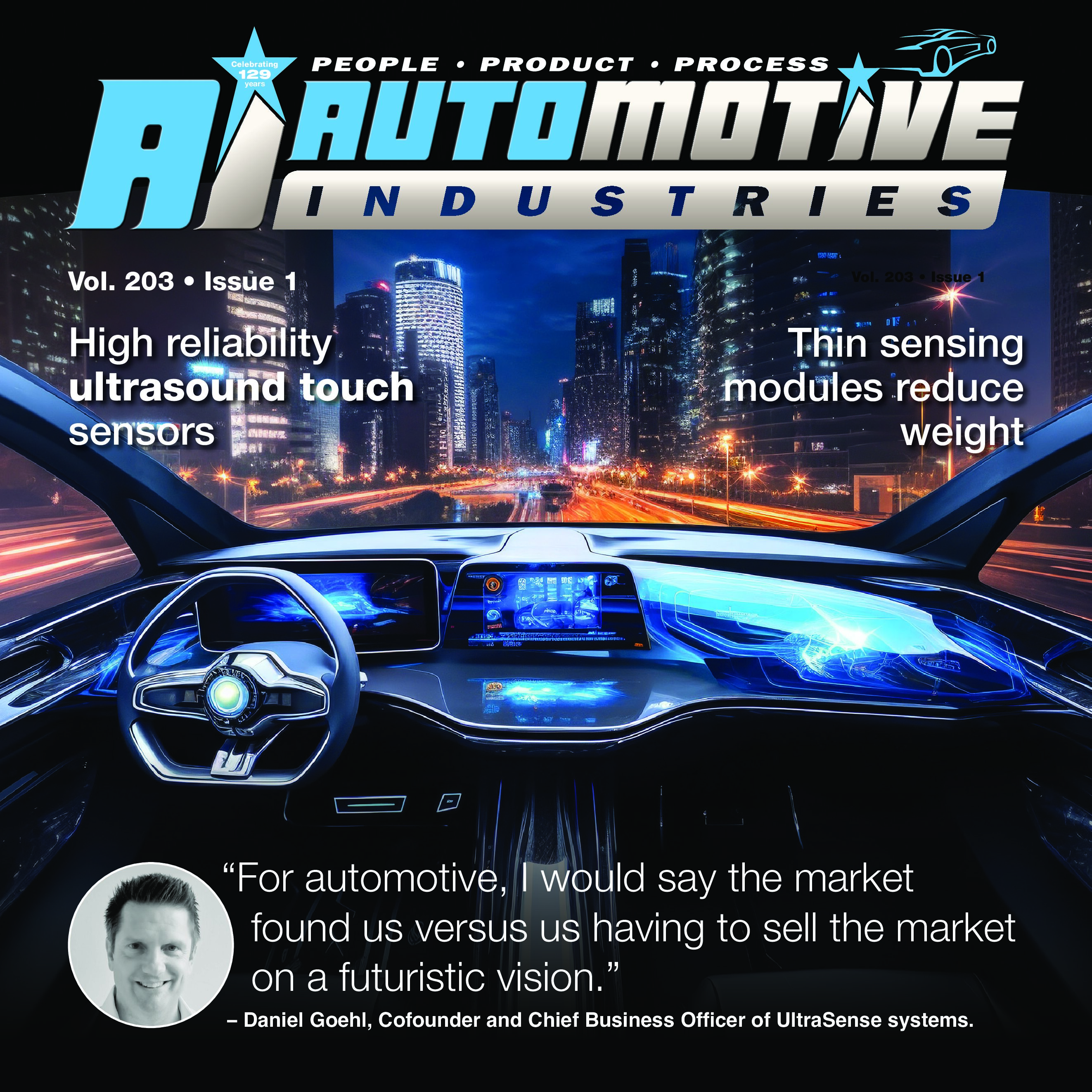
In a transformative leap from fantasy to reality, UltraSense Systems has pioneered the integration of superhero-inspired futuristic features, reminiscent of the Incredimobile, into everyday driving experiences.
The automotive market, recognizing the potential of UltraSense’s technology, approached them, marking a pivotal moment in the company’s trajectory.
As electric vehicles (EVs) emerge as smartphones on wheels, the transition from mechanical buttons to touch surfaces mirrors the evolution seen in smartphones around 2010.
The journey for UltraSense Systems began with the vision to use ultrasound as a touch user interface, replacing mechanical buttons in smartphones.
The successful adoption of their technology in smartphones propelled them into the automotive sphere.
Automotive Industries (AI) asked Daniel Goehl, Cofounder and Chief Business Officer of UltraSense Systems, how the company sees ultrasound touch user interfaces shaping the future of automotive design and user interaction.

Goehl: When we started UltraSense Systems, the inspiration was to use ultrasound as a touch user interface to replace mechanical buttons.
Ultrasound can penetrate virtually any material, but no one thought to use it as a button replacement.
As a startup, we were laser focused on getting our technology adopted into smartphones to replace the last mechanical buttons of volume and display control, and we quickly got designed into a couple of LG Mobile smartphones.
For automotive, I would say the market found us versus us having to sell the market on a futuristic vision.
From the time we published our first website in early 2019, we received sporadic inquiries from automotive Tier-suppliers about how our technology could enable “smart surfaces.”
We even provided free proof of concept (PoC) evaluation kits to seed the market.
After we emerged from stealth mode at CES in January 2020, interest changed to a steady stream of inquiries from not only Tier-suppliers but automotive OEMs too.
Today, we make the analogy that the automotive market is going through the same transition that smartphones did around 2010 with the transition of Blackberrys to iPhones.
Mechanical buttons replaced
Mechanical buttons were quickly replaced by tapping on a flat surface.
EVs are very much like a smartphone on wheels with a large power source streaming throughout the vehicle to drive a large display and other high-tech functions like ADAS cameras.
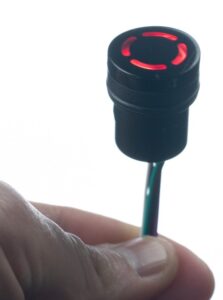
charge point Door
Tesla was really the company that set the standard for defining a modernized cabin and simplifying the interior design with the release of the Model S in 2012.
While Tesla did this to mostly save manufacturing costs by integrating most driver interaction functions normally controlled with mechanical buttons into a large display, this set the trend for the minimalist design aesthetic.
But with so many functions and apps buried within several menu levels of the display, this can make driving dangerous at times as drivers focus more on searching for functions than on the road.
UltraSense Systems technology allows for functionality that was put into the display to be put back into the areas of the vehicle that drivers intuitively know and can immediately touch and control without a cluster of ugly mechanical buttons or a dizzying array of lighted icons.
This makes the car safer.
In addition, we create a robust and premium touch experience on a true solid surface without requiring the material to move in and out of place.
Many of today’s so-called “solid surface” touch solutions feel subpar because they use optical sensors to sense force or mechanical micro-switches that require the material to flex, resulting in a clicky and stodgy feeling.
Finally, we provide ultra-thin and ultra-light solutions with our InPlane sensing modules.
This drastically reduces the thickness of the product design (e.g., steering wheel, center console panel, overhead console) and significantly reduces the amount of plastic used in the product design.

As a result, the reduction in weight directly translates into longer driving distances.
AI: What were the main challenges faced in developing this technology, especially in expanding the repertoire to unconventional materials like glass and stone?
Goehl: Two technologies are required to replace mechanical buttons.
You need both force sensing and capacitive touch otherwise the smart surface will trigger too easily with an unintended touch.
For example, in October 2022, Volkswagen’s CEO said the company was going back to traditional steering wheels with mechanical buttons.
Why the reversal? Drivers were frustrated with the capacitive touch steering wheels because a slight brush of the surface would trigger the volume sliders and button functions.
As a startup semiconductor maker, we always ask, “what problem are we trying to solve?”
In many cases, multiple mechanical system components can cost-effectively be replaced with one silicon chip.
Sensing chip
For smartphones, we created a MEMS multi-mode ultrasound and piezo-electric force sensing chip to replace the volume buttons, sensing a touch through 3mm of aluminum using ultrasound, and sensing a force even with the user wearing a thick ski glove, or thin, porous cotton glove.
For automotive, most Tier-suppliers are familiar with capacitive technology, but force sensing is still a challenge.
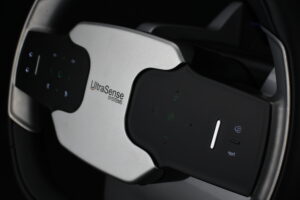
haptic slider module to replace plastic roller.
Capacitive can provide touch sensing through non-conductive materials up to a couple of millimeters in thickness, but the
industry needs higher reliability, so in most automotive use cases, force sensing is a must.
We offer a portfolio of chips to cover virtually any surface material. We call our chips Human Machine Interface (HMI) Controllers.
Not only do our chips provide multi-mode touch sensing, but they can also drive an LED to illuminate the surface icon and communicate directly with the haptic driver chip to provide tactile feedback.
Tier-suppliers and OEMs want a complete touch experience solution.
We get evaluated on how the haptic feedback feels in relation to the touch input.
Haptics
If the haptics do not feel good or the surface illumination looks bad, then it does not matter if the chip provides the best touch input performance.
Therefore, we look at replacing mechanical buttons from a holistic perspective of all three technologies together—multi-mode touch, surface illumination, and haptic feedback.

For haptics, we have developed our own simulation tools to optimize the mechanical design of the system to keep the energy in the surface material.
In addition, we have partnered with several haptic actuator makers and haptic driver chip makers to meet the premium feedback that OEMs demand.
Our latest demonstrators embody the collaboration and achievement of providing a premium touch experience solution that tier-suppliers can adopt and commercialize.
AI: How will consumers adapt to the elimination of traditional car door handles?
Goehl: Eliminating traditional methods with new technology takes time but can also happen quickly, especially if the change provides more convenience and a “cool factor” while saving cost and maintaining the highest level of safety.
Mechanical buttons and levers are most likely an interim solution for the solid surface trend to come.
A mechanical door handle with capacitive touch keyless entry encryption technology is not an inexpensive solution, especially when figuring in the cost of the cut out in the metal door panel and having to manually assemble the handle itself.
Being able to laminate a printed circuit board with capacitive and force sensing technology to the glass or plastic of the B-pillar of the car can be a more cost-effective solution to implement due to less manual assembly and less overall parts.
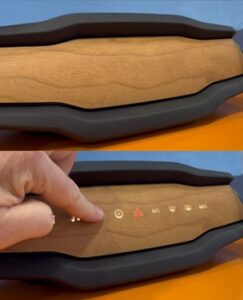
UltraSense collaborates with and leverages the deep experience and relationships that global tier-suppliers have with OEMs to develop and deliver a complete and reliable solid surface-based access solution that meet the stringent safety requirements of automotive OEMs.
As for consumers, adoption could be swift, if OEMs can demonstrate the convenience of not carrying a key fob and the feature proving itself to be tried and true without any frustrating glitches.
AI: Can you share some real-world scenarios or user experiences where this technology has proven to be particularly beneficial or innovative.
Goehl: The concept of “no more door handles” has been evolving over the years with the perfecting of encryption technology to access the vehicle.
Tesla, Hyundai and others have all but eliminated the bulky key fob with encryption performed by a digital key smartphone app.
Traditional door handles have been replaced by automakers such as China’s OEM HiPhi, which sells luxury vehicles, and US EV makers like Faraday Future and even Ford, which eliminated traditional door handles in the Mach E in favor of a mechanical button and lever located in the car’s B-pillar.
AI: Please tell us about the “secret until lit” smart surfaces.
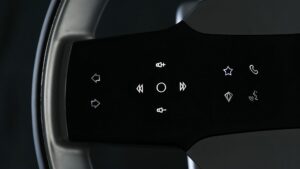
Goehl: “Secret until lit” smart surfaces go by other names, including “Shytech” and “dead front.”
The concept has been talked about for years and promoted mostly for display technology behind a deco film material, but now we will start to see it used for smart touch surfaces outside of the display and under different types of materials including textured painted plastics, glass, wood veneers, leather and even natural stone.
The premise is to turn certain intuitive locations of the car into active touch areas for the car’s occupants.
This includes the center console, overhead console, dashboard, side door panels, armrests, and even the steering wheel.
The active touch area would not be revealed with backlit icons until the occupant’s hand gets close to activate this functionality.
Until then, it is virtually impossible to discern any sort of icon—keeping the surface free of clutter and confusion.
Once the surface is activated and the function is triggered, occupants receive confirmation feedback via a sharp haptic vibration.
While the trend of automakers has been to load up the user interaction functionality into the display, “secret until lit” smart surface puts instantaneous access back into the fingertips of users, providing more convenience and better focus for the driver.
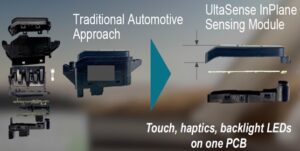
As cars continue to evolve with autonomous driving, we will one day achieve the futuristic image of going down the road encapsulated in a luxurious lounge on wheels.
AI: What are your predictions for the broader landscape of automotive technology?
Goehl: There is no doubt the market is moving to solid surface interfaces.
UltraSense Systems announced its first automotive production design wins in 2023 and plans to announce several new design wins in 2024 and 2025.
By 2027, we think most physical buttons will be replaced with solid surface interfaces in mid- to high-tier car models.
Car designers have been waiting for technology like ours.
UltraSense Systems’ holistic solution that combines multi-mode touch, surface illumination, and direct haptic communication will help drive adoption in more cars in the not-too-distant future.









More Stories
Towing Services Explained: 6 Key Facts You Need to Know
Environmental Factors That Influence Ceramic Coating Choices
Professional vs. DIY Tinting: What You Should Know